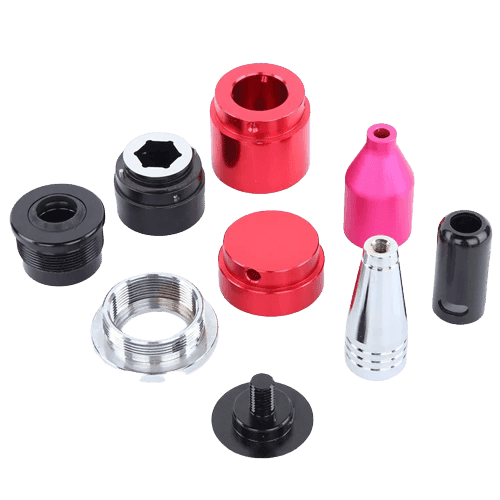Many aluminum parts need anodizing. But do you know why we need anodizing aluminum parts? Here is the answer.
What is Anodizing
Anodizing is an electrochemical process used to create a protective coating on the surface of metals, usually aluminum. It involves immersing the metal in an electrolyte solution and passing an electric current through it. This process creates a controlled oxidation of the metal’s surface, resulting in a durable and corrosion-resistant layer of oxide.
The anodized layer is porous, and the size of the pores can be controlled during the process to achieve desired properties like hardness, wear resistance, and coloring. The surface of the metal can be left in its natural color, or various dyes can be applied to create a range of vibrant colors.
Anodizing also improves the metal’s ability to accept adhesives and paint, making it a popular choice for architectural applications, automotive parts, consumer products, and many other industries. Additionally, the process can enhance the metal’s aesthetics by providing a smooth, consistent, and metallic appearance.
Overall, anodizing is a widely used surface finishing technique that enhances the performance, durability, and appearance of metals, particularly aluminum.
How Does Andizing Aluminum Work
Anodizing aluminum is a process that involves creating a layer of oxide on the surface of aluminum. This oxide layer serves to protect the aluminum from corrosion, as well as provide it with various desirable properties such as increased wear resistance, improved adhesion for paint and other coatings, and enhanced durability.
The anodizing process starts by cleaning and preparing the aluminum surface, usually through alkaline or acid cleaning. Once the aluminum is thoroughly cleaned, it is then immersed in an electrolyte solution and used as the anode in an electrical circuit. An electric current is passed through the aluminum, causing oxygen ions to be released from the electrolyte and react with the aluminum surface to form an oxide layer.
The thickness and properties of the oxide layer can be controlled by adjusting the process parameters, such as the voltage, current density, and duration of the anodizing process. Different types of anodization, such as sulfuric acid anodizing and hardcoat anodizing, can produce oxide layers with varying thicknesses and characteristics.
After the anodizing process is complete, the aluminum is typically sealed to further enhance its corrosion resistance and improve its appearance. This can be done through methods such as hot water sealing, chemical sealing, or dye sealing, depending on the desired outcome.
Anodized aluminum is commonly used in various industries, including architecture, automotive, aerospace, electronics, and consumer products. It is known for its durability, aesthetic appeal, and ability to be colored or dyed in a wide range of vibrant hues.
In summary, anodizing aluminum is a process that involves creating a protective oxide layer on the surface of aluminum through electrolysis. This process provides aluminum with improved corrosion resistance, increased wear resistance, and other desirable properties, making it a popular choice for a variety of applications.
Anodizing Aluminum Advantages
-
Increased corrosion resistance: Anodizing forms a protective layer on the surface of aluminum, making it more resistant to corrosion from moisture, chemicals, and other environmental factors.
-
Improved hardness and durability: Anodizing can significantly increase the hardness and durability of aluminum, making it more resistant to wear and tear, scratching, and damage.
-
Enhanced aesthetic appeal: Anodizing allows for a variety of coloring options, making aluminum anodized parts more visually appealing. It also helps to maintain the metallic look of aluminum while adding a glossy or matte finish.
-
Better adhesion for coatings: Anodized aluminum surfaces provide an excellent base for adhesion of various coatings, such as paints, primers, and glues, allowing for easier application and improved durability of these coatings.
-
Heat resistance: Anodized aluminum has improved heat resistance, making it suitable for applications where high temperatures are involved, such as automotive parts, cookware, and electronic housings.
-
Electrical insulation: Anodized aluminum has insulating properties, making it useful for applications that require electrical insulation, such as in electronic devices or electrical enclosures.
-
Environmentally-friendly process: The anodizing process is considered environmentally friendly as it doesn’t produce harmful byproducts or release toxic gases. Additionally, anodized aluminum can be easily recycled, reducing its impact on the environment.
-
Cost-effective: Anodizing is relatively cost-effective compared to other surface finishing processes like electroplating, making it a preferred choice for many industries.
-
Greater dimensional stability: Anodized aluminum parts have improved dimensional stability due to the anodizing process, ensuring that they maintain their shape and size even in demanding conditions.
-
Easy maintenance: Anodized aluminum requires minimal maintenance as the anodized surface is resistant to fading, chipping, and staining, allowing it to maintain its appearance and functionality over an extended period.

